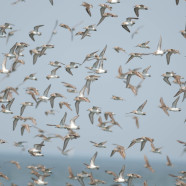Western Sandpiper (Calidris mauri)
Fall shorebirding can be very rewarding in a number of diverse habitats including farm fields, parking lots with pools of water, muddy pastures, grasslands, beaches, and rocky shorelines. Whether they are foraging, preening, or roosting there are always good chances to examine shorebirds for prolonged periods. That does not mean the task of identifying them will be easy! For every readily identifiable bird like the American Oystercatcher there seem to be a few difficult to discern species. The juvenile Western Sandpiper (Calidris mauri), as seen below and photographed in late August, can be...
Read MoreRuddy Turnstone
This beautiful Ruddy Turnstone (Arenaria interpres) was one of several feeding at Stratford Point in Stratford, Connecticut recently along with a small group of Semipalmated Sandpipers. Migrant shorebirds are now finishing moving north through the state, and it is hard to believe that in two months we will have many flying south. Please keep sharing any Connecticut eBird checklists with shorebirds, terns or long-legged waders with us at ctwaterbirds@gmail.com, thanks!
Read MoreSemipalmated Plover (Charadrius semipalmatus)
Record shot of an uncommon species for Chautauqua County, the Semipalmated Plover (Charadrius semipalmatus). Other shorebirds present included Semipalmated Sandpiper, Least Sandpiper, Killdeer and Spotted Sandpiper. Now it’s time to eBird my sightings so they are not lost into the void forever and you should do the same!
Read MoreSemipalmated Sandpipers (Calidris pusilla) by Twan Leenders
You can see the differences in plumage in this mass of migrant Semipalmated Sandpipers. Flocks of the species can have several thousand birds moving, feeding and resting together depending on the date and location.
Read More







